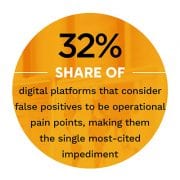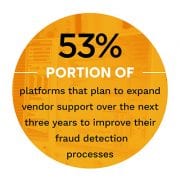In recent years, no type of business has expanded globally at the pace and scale of digital platforms. If there is a sine qua non to the growth of platforms like Airbnb, eBay and Uber, it is the seamless experience they offer their users. However, digital platforms face a major barrier in delivering these experiences: poor fraud detection.
 For digital platforms, fraud represents a two-headed beast. As largely online operations, they are tempting targets for fraudsters and hackers — therefore, robust anti-fraud systems are vital. At the same time, an overzealous system will flag too many legitimate users and could send them looking for alternative providers on the market. It’s this latter problem, known as false positives, that lies at the heart of digital platforms’ struggle to improve fraud detection.
For digital platforms, fraud represents a two-headed beast. As largely online operations, they are tempting targets for fraudsters and hackers — therefore, robust anti-fraud systems are vital. At the same time, an overzealous system will flag too many legitimate users and could send them looking for alternative providers on the market. It’s this latter problem, known as false positives, that lies at the heart of digital platforms’ struggle to improve fraud detection.
Just how great of a challenge this represents for digital platforms is starkly revealed in the new Payments 2022 Playbook: Building A High-Performing Payments Team For Fraud Detection, a PYMNTS study in collaboration with Stripe, for which 250 heads of payments representing various sizes and types of digital platforms were surveyed.
The report is part of a playbook series examining the growth strategies of digital platforms over the next three years. This edition focuses on how payments teams are coping with the vexing challenge of fraud detection — and how they may overcome it.
According to PYMNTS’ research, 60.8 percent of digital platforms consider too many false positives a key friction point in the conversion process, and 30.4 percent consider them the number one friction point, more than any other impediment. One likely reason false positives loom so large for digital platforms is that wrongly declining credit cards is a surefire way to alienate prospective customers — which is exactly what a digital platform intent on growing its user base shouldn’t do.
 Our research shows that digital platforms are taking a multi-pronged approach to dealing with fraud, including building their payments teams and expanding their work with vendors. Yet for all these efforts, platforms are decidedly dissatisfied with their capabilities in this area. Just 1.2 percent consider their fraud detection systems extremely effective, while 62.4 percent view them as only somewhat effective. Moreover, the amount of money and staff that platforms currently devote to fraud doesn’t make a dent in the dim view of their fraud systems. In fact, the more platforms invest in this area, the more likely they are to perceive false positives as a problem.
Our research shows that digital platforms are taking a multi-pronged approach to dealing with fraud, including building their payments teams and expanding their work with vendors. Yet for all these efforts, platforms are decidedly dissatisfied with their capabilities in this area. Just 1.2 percent consider their fraud detection systems extremely effective, while 62.4 percent view them as only somewhat effective. Moreover, the amount of money and staff that platforms currently devote to fraud doesn’t make a dent in the dim view of their fraud systems. In fact, the more platforms invest in this area, the more likely they are to perceive false positives as a problem.
Despite these challenges, some platforms are making progress in the fraud realm. Their practices suggest that hiring and outsourcing alone won’t suffice; the road to more accurate fraud detection runs through payments processors that are able to offer sophisticated, machine learning-based anti-fraud systems. To learn more about how platforms are cracking the code to improve fraud detection, download the report.
About the Playbook
The Payments 2022 Playbook: Building A High-Performing Payments Team For Fraud Detection edition, a PYMNTS and Stripe collaboration, examines how digital platforms’ payment teams can optimize their fraud-fighting strategies. To this end, PYMNTS surveyed 250 heads of payments representing various sizes and types of business-to-business (B2B) and business-to-consumer (B2C) digital platforms: B2C services marketplaces, B2B SaaS firms, B2C merchant marketplaces, B2C retailers and B2B platforms/utilities.